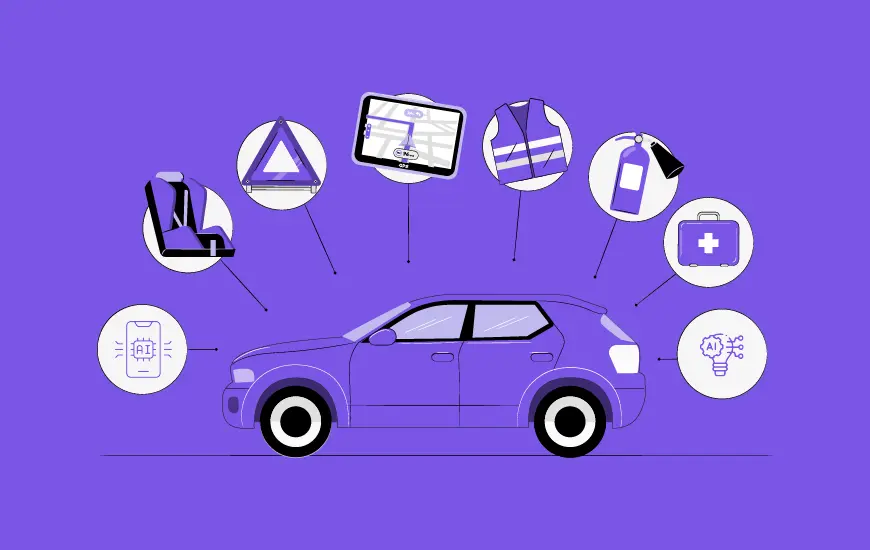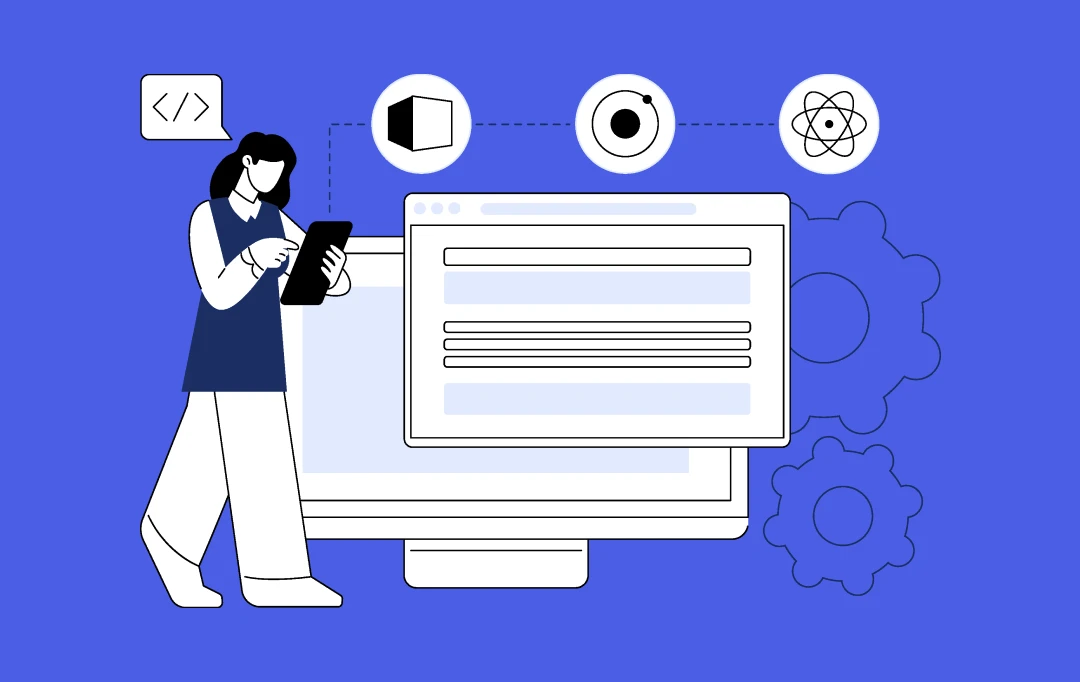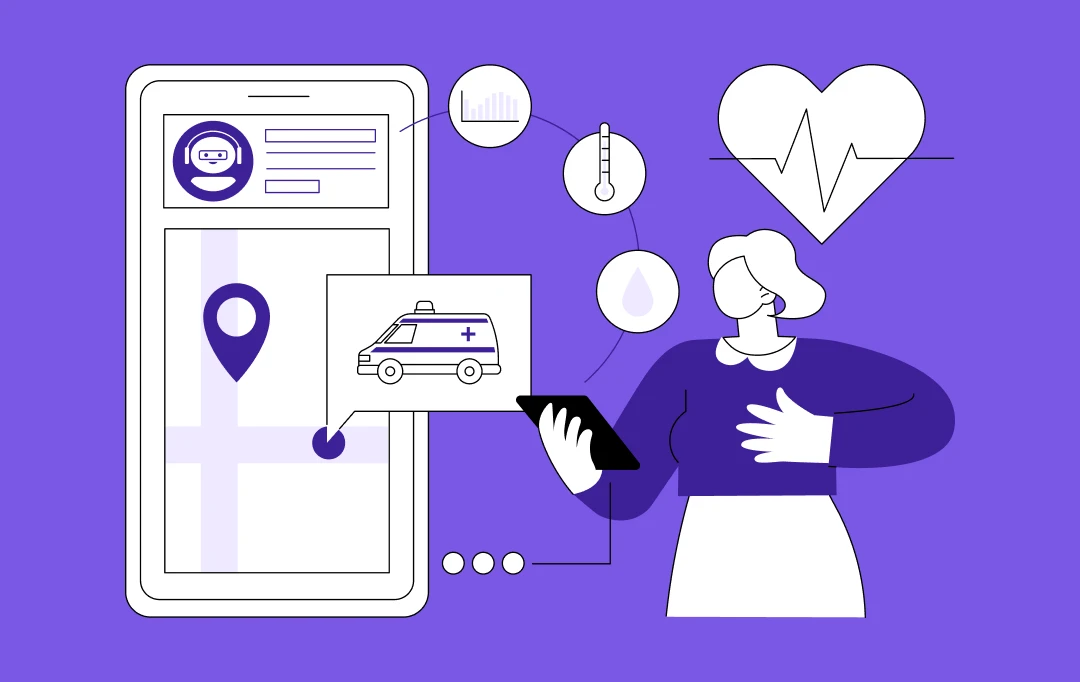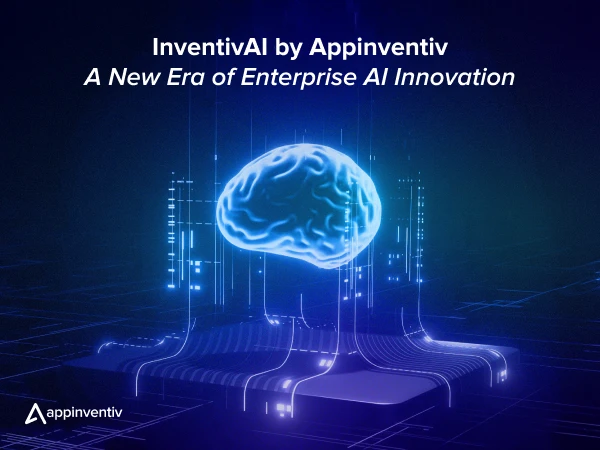- Development Blueprint For An AI Powered Queue Management System
- Requirement Analysis
- User Journey Mapping
- Technical Architecture
- AI Model Development
- UI and UX Engineering
- Integration Architecture
- Testing and Compliance Validation
- Deployment and Scaling
- Change Management and Staff Enablement
- Cost of Building an AI Queue Management System in the UAE
- Key Factors Affecting Cost
- Ranges for UAE Deployments AED 146,000 to AED 1,469,000 ($40,000 to $400,000)
- Why UAE Enterprises See ROI Quickly
- Benefits of AI Powered Queue Management System
- What an AI Powered Queue Management System Includes
- UAE Compliance and Security Requirements
- UAE Personal Data Protection Law (PDPL)
- Dubai Data Law
- NESA Information Assurance Standards
- Cloud Hosting and Data Residency
- Sector Specific Regulations
- Biometric Storage and Processing
- Global Standards for Security and Privacy
- Challenges and Solutions of Building an AI Powered Queue Management System
- AI Queue Management System Use Cases in UAE
- Airports & Travel Hubs
- Government Service Centres
- Healthcare & Clinics
- Retail, Malls & High-Traffic Venues
- Future Trends in AI Queue Systems for the UAE
- How Appinventiv Helps You Build an AI Powered Queue Management System in Dubai
- FAQs
Key takeaways:
- AI queue systems in Dubai improve service speed by predicting crowd flow, routing users intelligently, and supporting multilingual journeys.
- To build one, developers must align architecture with UAE needs: microservices, UAE cloud hosting, PDPL compliance, and seamless integrations with CRM, ERP, UAE Pass and WhatsApp.
- AI models are the backbone, powering forecasting, facial recognition, sentiment detection and real-time routing across multi-branch UAE environments.
- Enterprise-grade systems require rigorous testing for PDPL, Dubai Data Law, NESA standards and biometric accuracy before deployment.
- The cost to build AI queue systems in the UAE ranges from AED 146,000 to AED 1,469,000 ($40K to $400K), with ROI driven by shorter waits, higher throughput and lower operational effort.
Imagine walking into a government service centre in Dubai: the lobby hums with quiet anticipation, screens display waiting times, Arabic and English voices guide you to the right desk, and you barely pause to check in before you’re seated. Now imagine that same scene at an airport lounge, a high-street bank, a hospital reception or a major retail hub. That’s the promise of how to build an AI powered queue management system in Dubai and why many UAE organisations are racing to develop a custom AI queue management system to meet this expectation.
The UAE is already one of the world’s most digitally mature markets. DataReportal’s digital report shows that internet penetration in the UAE reached 99% at the start of 2025. This level of digital readiness explains why high-footfall industries across government, healthcare, banking, aviation and retail are accelerating plans to develop a custom AI queue management system that aligns with the country’s expectations for fast and intelligent service delivery.
With this growing demand, many enterprises partner with a trusted software development company in Dubai to design AI-powered queue management systems tailored to UAE’s service standards.
In a market where tourists, residents, and VIP users often share the same service space, traditional queue systems can no longer keep up. AI helps bridge this gap. From predicting peak hours to routing customers in real time, the new generation of queue systems supports the UAE vision for fast, seamless, customer-centric services. This blog explains exactly how to build one: the blueprint, the architecture, the features, the cost and everything you need to get it right for Dubai and the wider UAE.
Development Blueprint For An AI Powered Queue Management System
To build an AI powered queue management system in Dubai, you must treat the development blueprint as the core foundation. UAE service environments are complex. Footfall patterns shift between tourist seasons, public holidays, weekend peaks and weekday government rush hours. Multilingual users, VIP patrons, residents and tourists all expect a smooth experience.
A well structured blueprint ensures you can develop a custom AI queue management system that keeps pace with these real world patterns and delivers enterprise reliability across all branches.
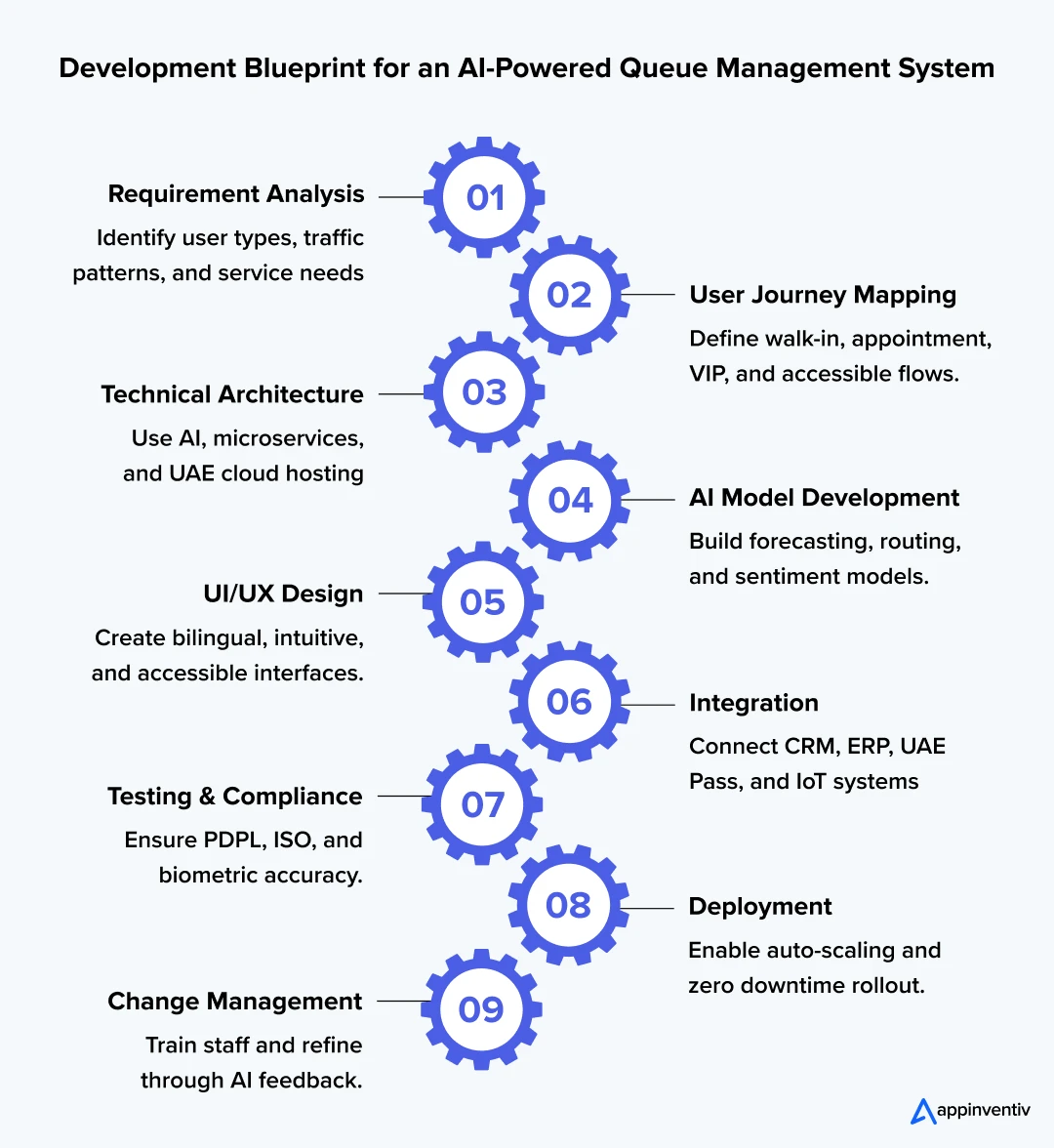
Requirement Analysis
This stage defines what the system must achieve. It starts with a detailed study of footfall, service categories, counter capacity, seasonal surges, VIP flows and typical service times. Deloitte’s Middle East government services insights note how Gulf countries must design systems that handle fluctuating traffic rather than static daily averages, since tourism cycles and economic events sharply influence usage.
Your analysis should capture:
- Visitor types: residents, expats, tourists, VIPs
- Daily and seasonal traffic behaviour
- Arabic and English language requirements
- Service types with expected handling times
- People of determination requirements
- Multi branch operations and counter load distribution
- Appointment vs walk in ratios
- Digital touchpoint expectations such as WhatsApp check in
This clarity sets the stage for the AI queue management software development process and prevents costly redesign later.
User Journey Mapping
Next, map the journeys for every category of user the system will support. Dubai and Abu Dhabi service environments often host a mix of user types in the same location, so precision matters.
A well defined journey includes:
- Walk in user flow: Kiosk check in, ID scan, digital token generation, and waiting time preview.
- Appointment user flow: Booking through app or WhatsApp, QR code check in, and dedicated appointment lanes.
- VIP or priority flow: Automatic routing to priority counters without manual approval. Essential for banks, airports and government service centres.
- Tourist flow: Simple multilingual screens and assisted kiosk modes for non familiar users.
- People of determination flow: Accessible UI, dedicated counter mapping, audio instructions and ergonomic kiosk setup.
- Multi branch routing: Directing users to the nearest branch with shorter waiting time when relevant.
A system that visualises these flows early can create an AI powered queue management system that feels intuitive rather than mechanical. These flows also shape the logic of the AI queue automation system used later.
Technical Architecture
A robust architecture ensures stability, scale and compliance across all UAE locations.
A modern design includes:
- Microservices architecture: Ticketing, routing, identity, notifications, reporting and analytics run independently for faster scaling.
- AI and ML engine: Models for crowd forecasting, routing intelligence, sentiment detection and facial recognition. This is the backbone of AI powered queue system design and development.
- Event driven processing: All changes in queue state, counter availability, and routing decisions propagate instantly using real time event streams.
- Front end ecosystem: Mobile app, WhatsApp Business integration, kiosk screens, digital signage and staff dashboards with Arabic and English support.
- Integration layer: API gateways that connect to CRM, ERP, HIS, banking systems, UAE Pass, DubaiNow, and POS tools.
- UAE cloud deployment: AWS UAE region, Azure UAE region or G42 for data residency and PDPL compliance.
This architecture enables organisations to make an AI based queue management system that can grow into multi branch operations without performance loss.
AI Model Development
AI is the layer that elevates a queue system from basic automation to a UAE ready enterprise solution. According to IBM’s UAE research, 77% of UAE business leaders say AI is already delivering significant improvements in efficiency and productivity. These gains happen when AI models learn from real operational patterns and apply those insights to automate decisions.
Your AI layer should include:
- Crowd forecasting models: Predict rush hours, long weekends, holiday surges and tourist season spikes.
- Routing optimisation models: Balance counters based on staff workload, service complexity, language preference and appointment priority.
- Computer vision models: Facial recognition for check in, occupancy analysis and queue movement tracking.
- Sentiment analysis models: Monitor facial expressions and body language patterns to flag frustration or long wait segments.
- Service time prediction models: Adjust routing and staffing recommendations based on expected service duration.
This AI layer strengthens AI queue management system development and enables advanced AI powered customer flow management for enterprises.
UI and UX Engineering
In the UAE, user experience must balance simplicity with cultural and linguistic diversity. This stage focuses on designing interfaces that anyone can use instantly.
Key considerations include:
- Mandatory Arabic and English flows
- Optional Hindi, Urdu and Filipino based on branch demographics
- High brightness, heat resistant kiosk screens for outdoor locations
- Touch targets and font sizes for accessibility
- Visual hierarchy for fast scanning in busy environments
- Kiosk modes for tourists unfamiliar with local systems
- Audio assistance for people of determination
- Clear escalation paths when queues exceed thresholds
UX engineers also design early prototypes for AI queue management app development, ensuring that the mobile experience mirrors the kiosk and branch experience seamlessly.
Integration Architecture
Enterprise queue systems in Dubai do not operate in isolation. They must sync with existing operational systems so customer journeys stay consistent.
Common integrations include:
- CRM systems for customer data
- ERP systems for workflow automation
- Hospital Information Systems for patient journey syncing
- Banking workflow engines for priority routing
- POS and billing systems
- UAE Pass for identity verification
- DubaiNow for government service flows
- WhatsApp Business API for digital check in
- IoT devices for occupancy sensors
This stage is critical for creating AI based queue management solutions in UAE that fit naturally into existing organisational systems.
Testing and Compliance Validation
Testing in the UAE goes beyond standard QA. It must align with regulatory expectations and high footfall reliability.
The testing suite includes:
- Load testing: Simulating Dubai Mall weekend traffic, RTA morning rush or airport peak hours.
- Security testing: Penetration testing, encryption validation and defence against identity spoofing.
- PDPL compliance validation: Checking consent flows, data storage rules, retention timelines and access protocols.
- Biometric accuracy testing: Verifying facial recognition across diverse ethnicities common in the UAE.
- Failover and disaster recovery: Ensuring continuity even if one branch or cloud node faces downtime.
This stage ensures the solution qualifies for AI queue management solutions for enterprise deployment.
Deployment and Scaling
Enterprise deployment requires planning for scale on day one.
Deployment considerations include:
- Choosing between UAE cloud regions or on premise setups
- Setting up container orchestration for multi branch usage
- Auto scaling rules for seasonal spikes
- Redundancy across multiple availability zones
- Edge processing for kiosks in remote or high traffic areas
- Zero downtime updates through rolling deployments
A well executed deployment ensures your organisation can develop a custom AI queue management system that grows without performance drops.
Change Management and Staff Enablement
Even the best system fails without proper adoption. This phase ensures staff, managers and administrators can operate the new system with confidence.
Activities include:
- Staff training on kiosk flows, priority routing and AI recommendations
- Admin dashboard training
- Creation of SOPs for multi branch operations
- Quick response guides for counter staff
- On site support during early weeks
- Feedback cycles to tune AI routing models
This final step is essential to actually create an AI powered queue management system that runs smoothly in day to day operations.
Cost of Building an AI Queue Management System in the UAE
The cost to build an AI queue management system in UAE varies based on how advanced the AI engine is, how many branches you operate, and how deeply the system integrates with enterprise tools. Because Dubai and Abu Dhabi run high-footfall, multilingual and compliance-heavy environments, budgets reflect engineering suited for real-time performance and PDPL-grade security.
Key Factors Affecting Cost
Here are the main elements that influence the factors affecting cost of AI queue management system in Dubai:
- AI model complexity: Crowd forecasting, routing optimisation, sentiment analysis and facial recognition significantly increase development effort.
- Number of branches: A system for one location is far simpler than a multi-branch architecture spanning Dubai, Abu Dhabi and Sharjah.
- Integrations with enterprise systems: Connecting to CRM, ERP, HIS, banking engines, UAE Pass, DubaiNow and WhatsApp adds engineering hours but is essential for full AI queue management system development.
- Compliance and cybersecurity: Meeting PDPL, Dubai Data Law, DHA, MOHAP and CBUAE requirements increases security configuration, encryption, data governance and audit setup.
- Hardware and IoT footprint: Digital kiosks, facial recognition cameras, tablets and IoT sensors add to overall deployment cost.
- Hosting requirements: Hosting in AWS UAE, Azure UAE or G42 (required for data residency) has a different cost profile compared to global regions.
- Multilingual mobile experiences: WhatsApp flows, AI chatbots and Arabic–English mobile apps require design, development and testing.
Ranges for UAE Deployments AED 146,000 to AED 1,469,000 ($40,000 to $400,000)
Below are realistic cost brackets based on UAE project scopes:
Basic Queue Automation System
- For small clinics, single counters or low-volume service centres. Includes ticketing, digital kiosks, basic dashboards.
- Estimated Range: AED 146,000 to AED 294,000 ($40,000 to $80,000)
AI-Driven Queue Management System
- Suitable for mid-sized hospitals, banks and multi-service venues. Includes AI prediction, routing, WhatsApp ticketing, IoT sensors and multilingual UX.
- Estimated Range: AED 330,000 to AED 734,000 ($90,000 to $ 200,000)
Enterprise Multi-Branch AI Queue Ecosystem
- Built for large operators across multiple emirates. Includes facial recognition, sentiment analysis, PDPL-safe storage, UAE Pass, DubaiNow, full analytics and microservices architecture.
- Estimated Range: AED 918,000 to AED 1,469,000+ ($250,000 to $400,000+)
Cost increases with scale, compliance depth and number of branches.
Why UAE Enterprises See ROI Quickly
Organisations in Dubai and Abu Dhabi investing in AI queue systems typically see:
- Shorter wait times and higher throughput
- Reduced manual staffing needs
- Higher customer satisfaction and lower walk-aways
- Real-time visibility across branches
- Stronger compliance posture
- Improved service quality during peak airport, tourist or government rush hours
This makes AI queue systems an operational asset rather than a cost centre, especially for multi-branch, high-traffic environments.
Benefits of AI Powered Queue Management System
The benefits of AI powered queue management system adoption extend far beyond shorter waiting lines. AI elevates how enterprises in Dubai and the wider UAE manage footfall, allocate staff, handle peak loads, and deliver consistent service across all touchpoints.
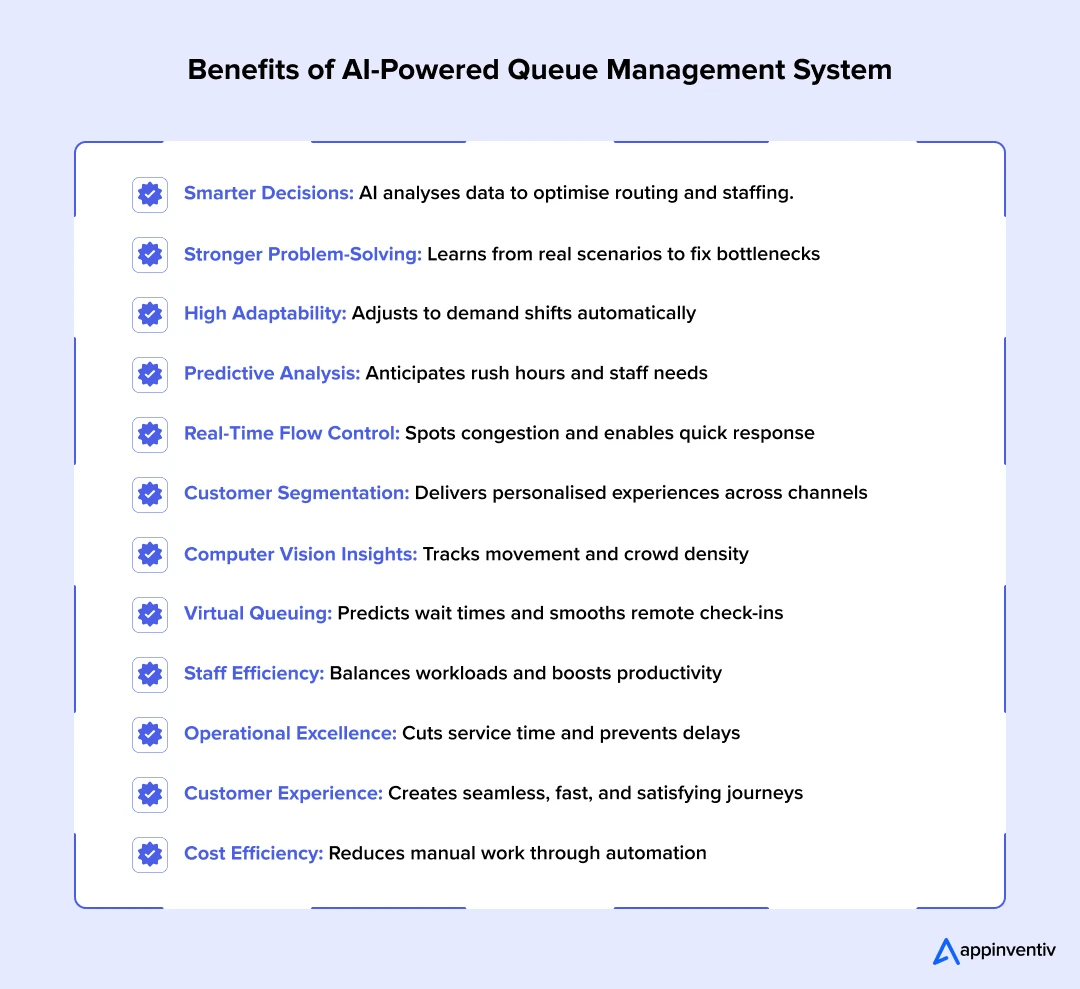
- Smarter Decision Making: AI analyses patterns, probabilities and historical behaviour to guide routing, staffing and counter allocation. This intelligence forms the core of AI-powered customer flow management for enterprises.
- Strong Problem-Solving Capabilities: AI learns from real service scenarios, adapts to new conditions and solves bottlenecks that manual or rule-based systems often miss.
- High Adaptability and Future Proofing: AI queue systems adjust automatically to shifts in customer behaviour, service demand and operational changes without relying on manual reconfiguration.
- Accurate Predictive Analysis: AI forecasts footfall, upcoming rush periods, staffing needs and service-time requirements with high accuracy, helping teams prepare proactively.
- Real-Time Flow Analysis: AI watches live data to detect congestion, slowdowns and queue build-ups, enabling quick corrective action and reducing service delays.
- Better Customer Segmentation: AI identifies user groups based on behaviour, visit patterns and service needs. This improves personalisation across kiosks, WhatsApp and mobile.
- Computer Vision Insights: AI uses CCTV inputs to understand movement, count visitors, track crowd density and differentiate between staff and customers. These insights strengthen operational control.
- Smarter Virtual Queuing: AI enhances remote ticketing by predicting wait times more accurately and optimising virtual journeys from check-in to service completion.
- Enhanced Staff Performance: AI tracks workload distribution, performance metrics and counter efficiency. Managers get actionable insights to allocate resources more effectively.
- Higher Operational Efficiency: AI reduces service time, prevents bottlenecks and improves overall throughput, making everyday operations faster and more reliable.
- Improved Customer Experience: Shorter waits, accurate routing, personalised updates and proactive communication help raise satisfaction for residents, expats and tourists.
- Lower Costs Through Automation: Automation reduces manual work and staff dependencies. This makes AI queue management solutions for enterprises more cost-effective over time.
What an AI Powered Queue Management System Includes
When you build an AI powered queue management system in Dubai, the value comes from how well the system can predict, adapt and personalise each journey. Below are the core AI queue management system features designed for fast-changing UAE service environments.
- AI Prediction Engine: AI forecasts crowd flow using patterns from footfall, service times, holiday cycles and airport traffic. This is where the Role of AI in Enhancing Queue Management Systems becomes clear. The system prepares before queues build by adjusting counters and routing automatically.
- Intelligent Routing and Load Balancing: Models analyse service type, counter availability, staff skills, language preference and priority level to route users accurately in real time. This improves waiting time accuracy across diverse user groups.
- Computer Vision Check In: Facial recognition, ID scanning and movement tracking support contactless check-in in airports, clinics and government centers. Computer vision also monitors congestion and triggers rerouting when needed.
- Sentiment and Experience Monitoring: AI detects sentiments (stress or frustration) through expression and posture cues. Supervisors get alerts to intervene early, improving service quality during busy periods.
- WhatsApp and Mobile Intelligence: AI chatbots allow users to take a digital ticket, check wait times, reschedule, upload documents and get turn notifications. Arabic and English intent detection keeps the experience seamless.
- IoT and Occupancy Insights: Sensors track movement and density across malls, airports and halls. This data helps balance counters and maintain safe, predictable flow during peak hours.
- Multilingual AI Assistants: AI guides users through check-in and queue updates in their preferred language. This reduces confusion and strengthens AI powered customer flow management for enterprises that serve residents, expats and tourists.
- VIP and Priority Identification: AI identifies VIP or priority users from mobile identity, Emirates ID or facial recognition and routes them instantly to the correct counter. This ensures consistent premium service across UAE banks, airports and government centers.
UAE Compliance and Security Requirements
Compliance shapes every design decision when you build an AI powered queue management system in Dubai. The UAE strengthened its data protection landscape with the Federal Decree-Law No. 45 of 2021 on Personal Data Protection, which became fully enforceable in January 2023. This means every organisation collecting personal or biometric data must meet strict legal requirements from day one. Queue systems touch identity data, mobile numbers, service patterns and sometimes faces, so compliance is a structural requirement, not an add-on.
UAE Personal Data Protection Law (PDPL)
PDPL governs how personal data is collected, stored, shared and retained. According to UAE legal guidance, the law sets obligations for consent, purpose limitation, breach notification, cross-border transfers and individual rights. For queue systems handling Emirates ID details, phone numbers or facial recognition, PDPL compliance requires encrypted storage, minimised data collection and transparent user rights.
Dubai Data Law
Dubai Data Law sets out how government and private sector entities must classify, process and share data. This impacts routing logs, identity verification flows and service histories. All data must be processed with controlled access, governance rules and clear audit trails.
NESA Information Assurance Standards
NESA provides cybersecurity controls for critical infrastructure across the UAE. These standards require strong endpoint protection, network segmentation, device hardening, incident readiness and continuous monitoring. Systems that rely on kiosks, IoT sensors or biometric devices must align with NESA to remain secure in public environments.
Cloud Hosting and Data Residency
Data residency is a major consideration because PDPL restricts cross-border transfers unless strict conditions are met. Most organisations prefer local cloud hosting using AWS UAE, Azure UAE or G42. This trend is reflected in market growth. Mordor Intelligence reports that the UAE cloud computing market reached $12.84 billion in 2025, with projected growth to $45.41 billion by 2030. This shows how rapidly enterprises in the country are shifting toward compliant, locally hosted cloud systems.
Sector Specific Regulations
Different industries must align with their own regulators:
- Healthcare: DHA and MOHAP require secure handling of patient data and restrict use of biometric information.
- Banking: CBUAE guidelines apply to identity verification, authentication, fraud prevention and retention rules.
- Financial Services: SCA rules apply to customer data processing and service workflow visibility.
These sector rules ensure the system behaves responsibly within the organisation’s domain.
Biometric Storage and Processing
For facial recognition check in, biometric data must follow strict rules. PDPL prohibits unnecessary biometric collection and requires secure storage, encryption, limited access and documented justification for usage. Biometric templates should be anonymised where possible and retained only for operational necessity.
Global Standards for Security and Privacy
To support audits and enterprise trust, organisations align their queue systems with:
- ISO 27001 for information security
- ISO 27701 for privacy management
These standards ensure consistent protection across AI pipelines, databases, integrations and deployed hardware.
Challenges and Solutions of Building an AI Powered Queue Management System
Building an AI powered queue management system involves more than adding automation. It requires engineering a platform that can scale across multi-branch environments in Dubai while staying compliant with PDPL and supporting real-time decision-making. Understanding these challenges early helps teams create an AI powered queue management system that performs reliably in high-traffic settings.
- Real-Time Footfall Prediction Across Branches
Traffic spikes in Dubai can shift in minutes, especially during peak tourism days, airport rush hours and weekends.
Solution: ML models trained on historical patterns and live sensor data predict load before queues build. This early visibility is one of the core benefits of an AI powered queue management system, because it reduces congestion and improves throughput instantly.
- Multilingual and Multi-User Journeys
UAE branches serve citizens, expats, tourists, VIP clients and corporate customers, each with unique service needs.
Solution: Developers build multilingual NLP flows, persona-based routing, and WhatsApp ticketing in Arabic and English. This ensures the system can support every journey when you create an AI powered queue management system tailored for diverse customer types.
- Integration With Legacy and Modern Systems
Many organisations still depend on older CRMs, POS systems, home-grown ERPs or on-prem healthcare systems that don’t align easily.
Solution: A microservices-powered integration layer using REST APIs, GraphQL and event streams ensures consistent data movement across all connected platforms. This reduces overall engineering effort and lowers the cost to build an AI queue management system in UAE when done correctly from the start.
- Building an Accurate Routing Engine
Misrouted customers cause long queues, higher SLA failures and unnecessary frustration.
Solution: Developers combine deterministic rules, ML-based decision engines and reinforcement models to keep routing accurate under shifting conditions. Over time, the engine learns from past flows and gets more precise.
- Compliance With PDPL, Dubai Data Law and Biometric Standards
Queue systems often process identity information, mobile numbers and facial recognition. Compliance is non-negotiable.
Solution: Teams implement UAE-cloud hosting, end-to-end encryption, audit logs and isolated biometric vaults for compliant data handling. This keeps the system aligned with UAE’s regulatory requirements from day one.
- Hardware Reliability in High-Footfall Areas
Outdoor kiosks, mall stations and airport counters face harsh environmental and usage stress.
Solution: Robust hardware, edge failover logic and automatic mobile fallback ensure no single device failure breaks the service flow.
- Scaling Across Multiple Branches
Government service centres, hospitals and banks often run tens of branches with different traffic patterns.
Solution: Containerized deployments (Kubernetes), multi-zone redundancy and load balancing ensure the system grows without performance issues as new branches go live.
AI Queue Management System Use Cases in UAE
In high-traffic environments across Dubai and the UAE—airports, government services, hospitals, banks and malls—the need for precision, speed and multilingual service is pressing. Deploying an advanced platform to build an AI powered queue management system in Dubai and UAE brings structure, predictability and responsiveness to these fast-moving spaces.
Airports & Travel Hubs
At Emirates Terminal 3 at Dubai International Airport (DXB), over 200 biometrics-enabled cameras were installed under an AED 85 million investment to enable passengers to move from check-in to boarding using facial recognition instead of showing documents.
This real-world application shows what happens when you apply AI queue management system features: fewer manual steps, faster movement, and real intelligence behind service flows.
Government Service Centres
Across a number of UAE hospitals and public service branches, significant improvements have been reported. For instance, one health services provider eliminated 220 procedures and achieved a 60% reduction in service wait times through streamlined processes and digital queueing.
Such outcomes reflect the potential of AI-powered customer flow management for enterprises to transform the citizen experience in government-run service centres.
Healthcare & Clinics
In the UAE, many hospitals have adopted queue management systems across dozens of facilities. For example, one project covered 35 hospitals, reducing waiting time and improving operational efficiency through flow optimisation.
When you implement AI queue management solutions for enterprise, healthcare is a natural fit: scheduled appointments, walk-ins, emergencies—each fits into intelligent routing and service orchestration.
Retail, Malls & High-Traffic Venues
Retail locations in Dubai’s busy commercial districts face weekend peaks, tourist surges and multilingual customer bases. Solutions that integrate digital ticketing, real-time wait-time updates and mobile check-in are now reducing average wait time.
These are prime examples of how intelligent queue platforms bring value when you apply AI queue management solutions for enterprise in customer-facing, high-volume environments.
Future Trends in AI Queue Systems for the UAE
The UAE is moving fast toward fully digital, contactless and AI-driven service delivery. As organisations modernise their operations, the next wave of queue systems will go beyond routing and ticketing. Here are the trends shaping the future of AI powered queue management across Dubai and the wider UAE.
- Autonomous, Self-Learning Queue Engines: Queue systems will no longer rely on fixed rules. AI models will learn from branch behaviour, service duration patterns and seasonal footfall to optimise routing automatically. The system will adjust counters, predict bottlenecks and recommend staffing changes without manual intervention.
- Full Integration with UAE Pass and Unified Digital Identity: With UAE Pass becoming the country’s single trusted digital identity, future queue systems will instantly recognise users, fetch their service history, prioritise appointments and personalise journeys the moment they scan in.
- Contactless Experiences Through Biometrics and IoT: Facial recognition, motion tracking and IoT sensors will support check-ins, counter routing and crowd visibility without users touching a kiosk. This trend grows as airports, malls and government centres expand biometric adoption.
- Hyper Personalised Service Flows: AI will create customised paths for each user based on past visits, preferred language, appointment type or urgency level. For example, UAE residents may receive fast-track routing for frequently used services, while tourists receive guided instructions tailored to their needs.
- Predictive Branch Management: Managers will rely on predictive dashboards to forecast load days in advance, identify staffing gaps, and simulate what-if scenarios. This helps enterprises prepare better for long weekends, holiday seasons and travel spikes.
- Omnichannel Queue Experiences: WhatsApp, mobile apps, website widgets and self-service kiosks will merge into one experience. Users will be able to take a ticket from anywhere, receive alerts, reroute to quieter branches or join a virtual queue from home.
- Compliance-Driven Architecture by Default: With PDPL, Dubai Data Law and sector regulations strengthening year after year, future systems will come pre-aligned with consent management, biometric governance, local data residency and audit-ready reporting.
How Appinventiv Helps You Build an AI Powered Queue Management System in Dubai
Appinventiv works closely with organisations across the UAE to design and deploy queue systems that can handle real-time routing, multilingual users and strict compliance. With 1000 plus digital projects delivered in the Middle East and 10 years of regional experience, we understand how to build solutions that work at the scale of Dubai’s airports, hospitals, banks and government centres.
As an AI development company in Dubai, we combine deep AI expertise with strong local knowledge. Our teams have 20 plus strategic partnerships, 3 regional excellence centers, and a 95% client satisfaction rate across the region. We have modernised 500 plus enterprise workflows, delivered solutions across 35 plus industries, and executed 12 government and compliance programs, giving us the experience to build systems aligned with PDPL, Dubai Data Law, DHA, MOHAP and CBUAE.
For organisations looking to build an AI powered queue management system in Dubai, we offer end-to-end engineering. This includes AI model development, mobile and WhatsApp ticketing, IoT-enabled routing, cloud hosting in UAE regions, and enterprise integrations.
We also help businesses plan the cost to develop an AI product in Dubai through realistic scoping, phased delivery planning and budget alignment with operational goals. Instead of fixed assumptions, we provide clarity on what drives total investment and where costs can be optimised without compromising performance or compliance.
Ready to innovate your business with modern technology? Contact our experts.
FAQs
Q. How do I implement AI queue management in Dubai?
A. To implement AI queue management in Dubai, start by defining your branch workflows, data sources and service categories. Next, integrate kiosks, mobile ticketing and WhatsApp flows with an AI engine that predicts footfall and automates routing. Compliance with PDPL and Dubai Data Law is essential, so host all data in UAE cloud regions. Working with an engineering partner like Appinventiv makes it easier to build an AI powered queue management system in Dubai that is scalable, compliant and ready for multi-branch deployment.
Q. Why is a Queue Management System essential in cities like Dubai?
A. Dubai handles heavy footfall across airports, government centres, banks, clinics and retail hubs. A queue management system helps control congestion, improve service speed and give customers predictable waiting times. It also supports multilingual journeys, which is essential in a diverse city. For organisations managing daily peak loads, queue systems reduce operational pressure and keep the overall experience smooth.
Q. How does AI enhance a Queue Management System?
A. AI improves queue systems by predicting peak hours, optimizing routing in real time and identifying service bottlenecks before delays form. It analyses patterns like wait times, staff availability, user categories and service duration to keep the flow balanced. AI also enables facial recognition check-ins, sentiment understanding and multilingual guidance that old systems cannot offer.
Q. What industries benefit most from AI queue management in the UAE?
A. Industries with high daily footfall see the largest impact. This includes hospitals, banks, telecom operators, government service centres, airports, retail chains and large malls. These environments depend on fast movement and multilingual service, making AI automation a natural fit.
Q. What is the cost to build an AI queue management solution in the UAE?
A. The cost depends on branch size, AI complexity, integrations and compliance requirements. Basic systems may start at AED 146,000 ($40,000), while advanced multi-branch deployments with facial recognition, WhatsApp automation, IoT sensors and real-time AI routing can reach AED 1,469,00 ($400,000). The investment pays off in efficiency gains, higher throughput and reduced staffing dependencies.


- In just 2 mins you will get a response
- Your idea is 100% protected by our Non Disclosure Agreement.

How Much Does It Cost to Build an AI App in Dubai?
Key takeaways: AI app costs in Dubai typically range from AED 80,000 for simple builds to AED 800,000+ for enterprise systems. Dubai is past AI experimentation, and not investing now means catching up later at higher cost. The real budget is driven by data, integrations, architecture, and compliance, not just app features. Hidden costs like…

How AI Tokenization is Enabling Secure and Transparent Asset Ownership in 2026
By 2026, AI tokenization has moved beyond early-stage experiments and pilot projects. Tokenizing real-world assets has become a serious commercial strategy for financial institutions, supply chain operators and technology-driven enterprises. A 2025 report by the World Economic Forum in collaboration with Accenture highlights tokenization as a key mechanism for value exchange in modern financial markets.…

13 Ways Generative AI is Transforming the Hospitality Industry
Key takeaways: The most mature applications of Generative AI for hospitality are in guest service, revenue management, marketing, and operations automation. Real value comes from integrating generative AI into hospitality operations and existing PMS, CRS, CRM, and POS systems, rather than using stand-alone tools. Successful programs treat Generative AI in hospitality as a product, incorporating…








